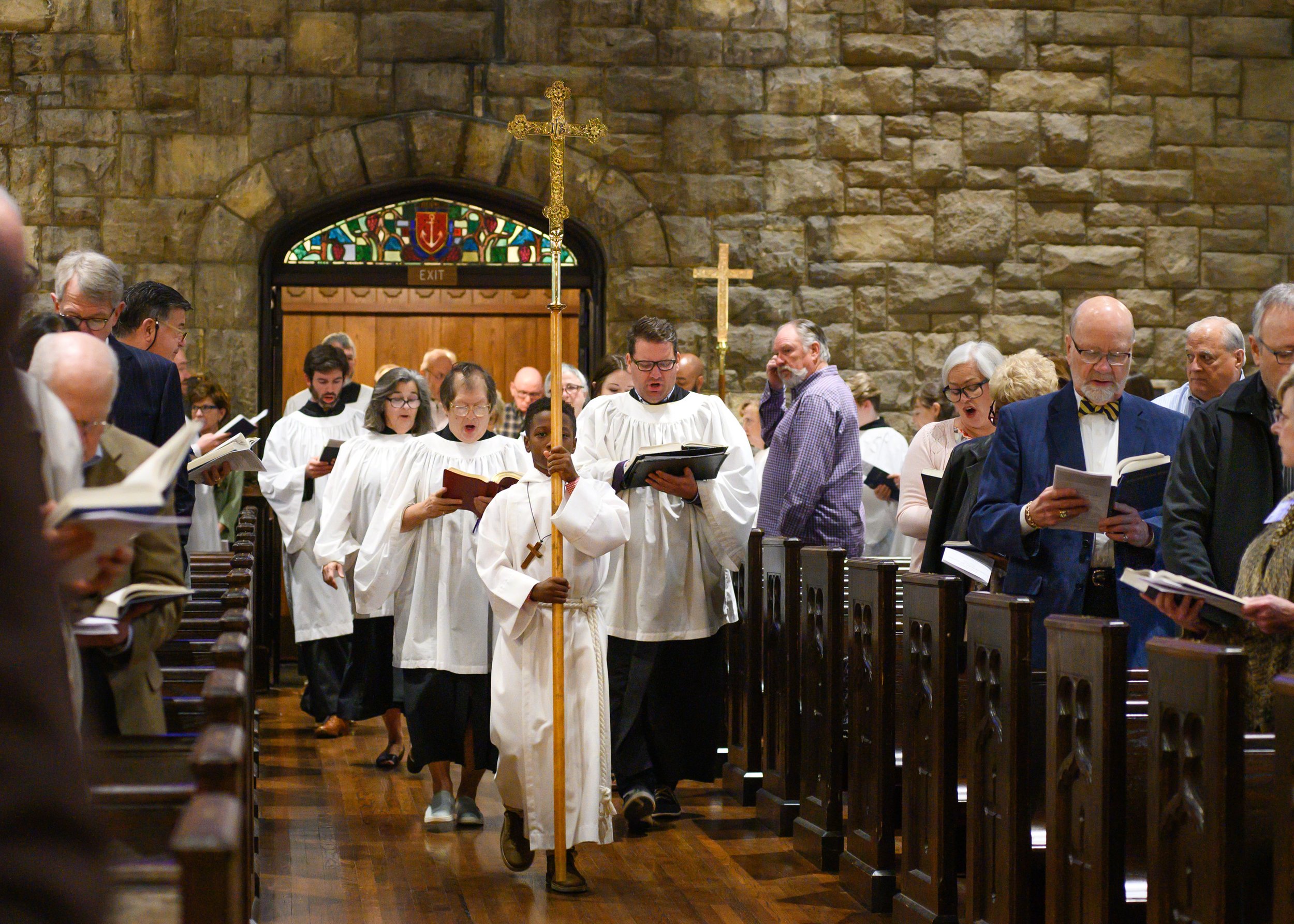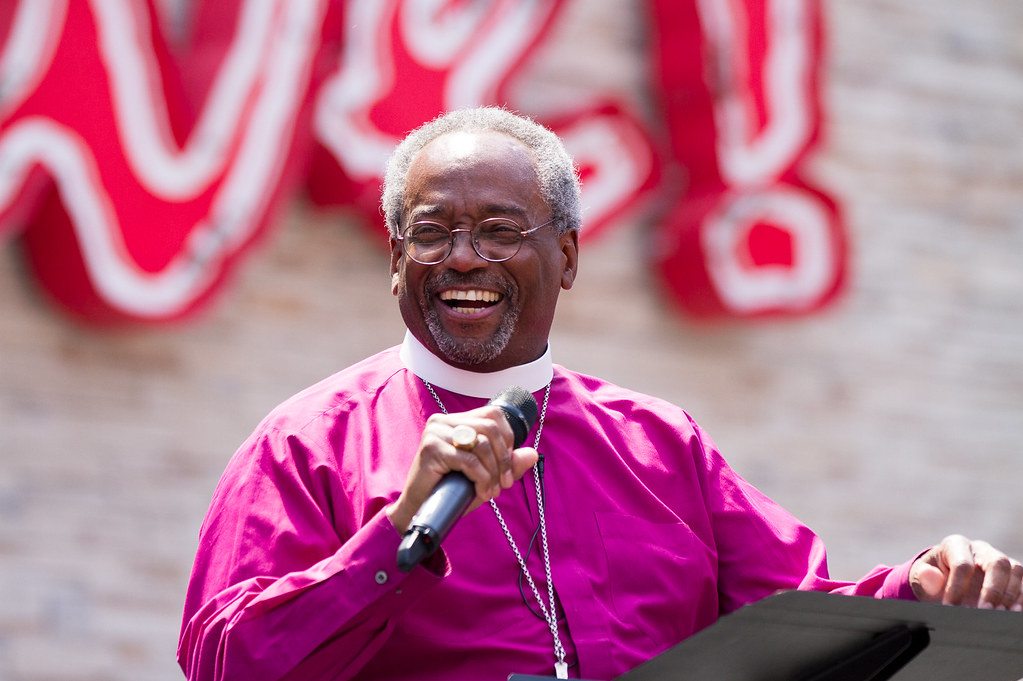Who We Are
The People and History of St. Paul’s
Then
Westport was booming as a wagon train outfitting station in the 1850s when a group of Episcopalians planted the seeds for today’s St. Paul’s Episcopal Church. The town provided supplies to pioneers, traders, trappers and others as they prepared to head west on the Santa Fe, Oregon and California Trails. The Episcopalians are believed to have met regularly on their own, and they made clear their desire for clergy to meet with them. The bishop of the Diocese of Missouri sometimes visited, as did a priest based at a church in what is now downtown Kansas City. But there was no Episcopal church or parish in Westport.
Records of visits by the clergy to Westport became sketchy as the years passed, and some families are known to have trekked to two Episcopal churches located downtown. But the desire for an Episcopal church in Westport did not wane. The area grew, and in 1890 a downtown church started a mission in Westport and purchased a small yellow brick building to serve as the mission church. Westport Episcopalians soon pressed hard to graduate from mission status to become their own parish. They succeeded and, in 1891, a new parish named St. Paul’s was admitted in the recently-created Diocese of West Missouri. St. Paul’s bought the little yellow church building from the downtown church the following year.
St. Paul’s was finally finding its identity and a place in Westport.
As families settled and the area continued to grow, St. Paul’s looked for a more permanent location. In 1905, it bought property at 40th and Walnut Streets and soon began building the stone church sanctuary/nave that is home to St. Paul’s today. The first service was held in the sanctuary/nave on April 1, 1906. Two years later, the church added more land, at 40th and Main Streets.
St. Paul’s and the neighborhood have evolved with Kansas City. Main Street was paved in 1916. All pew seating became free of charge not long afterward. And the church turned its attention outward, providing space for the Red Cross during the first world war and assisting children from “broken homes.”
Today
Today, St. Paul’s operates five food assistance programs. Those food ministries help feed more than 2,000 people each month. The programs are tailored to senior citizens, young students and anyone in between who just needs a helping hand.
And the church today shares a campus with the highly regarded St. Paul’s Episcopal Day School. It opened in 1963 with an enrollment of 43 students and a staff of four. It now has an enrollment of about 450 students from age two through the eighth grade, supported by about 70 faculty and staff. The church and school occupy an entire city block. Most of an adjoining block serves as sporting fields for the school. The school aims to live up to the reputation of Episcopal schools for educational excellence and to develop character and leadership in preparing the leaders of tomorrow. It seeks to integrate the concepts of equity and a just society throughout the life of the school.
The church and school also provide financial support for a sister school in Haiti. The Holy Cross School has about 380 students. The school is the primary hope for the students’ future in a very rural area of Haiti where no national schools operate.
The church offers to parishioners (children and adults) programs for Christian learning and spiritual development in its commitment to the faith formation of each person, life-wide and life-long.
Our church is rich with that history and commitment. The limestone nave/sanctuary’s ceiling soars above walls lined with century-old stained-glass windows stretching upward. The windows illustrate scenes from the Bible, beginning with the birth of Jesus and ending with his crucifixion and the good news of his resurrection.
Music fills the church on Sundays, often beginning and ending with works by masters like Bach, Ravel, and Mendelssohn, or by the renowned members of our music staff. Vocals from our magnificent choir soar into the dome overhead, joining with the vibrant tones from the pipes of our 1966 Schantz Opus organ and the voices of our congregation.
The church draws members from throughout the area. While many live nearby, almost 60 percent of members live five miles or more from the church. And almost 20 percent of the congregation lives more than 15 miles away.
St. Paul’s created a video about 2015 in connection with a past capital campaign. Congregation members narrating the video describe how the church’s history of service to the people of Kansas City has evolved and how the legacy of that service continues to build for the future. They describe why we come to church, why we choose St. Paul’s.
We come to discover God and His purpose for our lives; whether attracted by the music and liturgy, the friendly openness of the people, opportunities for outreach, for fellowship, the proclamation and teachings of the Gospel of Jesus, the need to experience the grace and love of God or any variety of personal needs, St. Paul’s is a house of prayer for all who feel called by God.
Click here to watch that six-minute video, to see and learn more about us.
For more information about St. Paul’s and its activities today, check out our social media pages, linked in the footer of this website.
Being a Christian is not essentially about joining a church or being a nice person, but about following in the footsteps of Jesus, taking his teachings seriously, letting his spirit take the lead in our lives, and in so doing helping to change the world from our nightmare into God’s dream. – Presiding Bishop Michael Curry of The Episcopal Church
We believe that God loves you – no exceptions.
We Episcopalians believe in a loving, liberating and life-giving God: Father, Son and Holy Spirit. As constituent members of the Anglican Communion in the United States, we are descendants of and partners with the Church of England and the Scottish Episcopal Church and are part of the third largest group of Christians in the world.
We believe in following the teachings of Jesus Christ, whose life, death and resurrection saved the world.
We have a legacy of inclusion, aspiring to tell and exemplify God’s love for every human being; women and men serve as bishops, priests and deacons in our church. Laypeople and clergy cooperate as leaders at all levels of our church. Leadership is a gift from God, and can be expressed by all people in our church, regardless of sexual identity or orientation.
Our faith is based on three foundations:
Scripture
Tradition
Reason
Learning about God’s word, and how we should respond to it, is central for us. Our worship and religious education and practice encourage us to engage in thoughtful reflection and insights about what God’s call means to each of us, as followers of Christ. We rely on those three foundations in that process.
One of the wonderful things about being an Episcopalian is that we believe it is okay to struggle with our faith, and that on those Sundays when we ourselves have a hard time professing our belief in one tenet of the Creeds or another, the rest of the congregation is there to support us, or as is often said, to believe it for us.
To learn more about the Episcopal Church, consider visiting the following websites:
Episcopal News Service – Stories across the Episcopal Church and Anglican Communion
The Episcopal Diocese of West Missouri – our Regional News and updates




